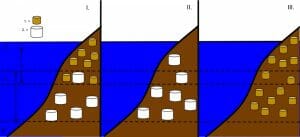Fundamental Niche Definition
The niche of any organism is the role that it fills within an ecosystem as a response to the amount and distribution of resources, the competition present, and the way that the organism influences those same factors.
A fundamental niche is the full range of environmental conditions that a viable population of species can occupy and use, without any other limiting factors present which could constrain the population.
In contrast, the actual niche or the ’realized niche’ that an organism fills is often much less efficient in terms of resource-use, due to the presence of other species competing for resources, intraspecific competition, predation and environmental stresses which prevent the acquisition of the resources.
The fundamental niche is the potential niche that could be filled and is affected by the life history traits of each species and each individual organism – their dispersal ability, their tolerance to different environmental conditions, and the way in which they interact with other species.
Examples of Fundamental Niche
Sparrows in a Forest
Within a forest, a population of sparrows feeds on berries that grow abundantly on bushes. The fundamental niche of the sparrows is the area where there are berries, and covers the whole of each bush as well as the forest floor, where many of the berries have fallen to the ground. However, mice, which live on the forest floor, also like to eat berries, and are quick to collect them once they have fallen. The presence of the mice causes interspecific competition and means that there are fewer or no berries to eat on the forest floor. The fundamental niche of the sparrows cannot be met, so they fill the realized niche, which is the area on the bush branches only.
The interspecific competition between the sparrows and the mice affects the geographic range of the populations; however, the individuals within the populations are also affected by intraspecific competition. Certain bushes within the forest may receive more light, nutrition or water than other bushes, and therefore may yield larger and more nutritious berries. Sparrows that are larger or more aggressive could claim territorial ownership over the best bushes and the actual niche of the smaller sparrows (fundamentally, covering all of the bushes in the absence of other sparrows) would be restricted to bushes with smaller, less nutritious berries.
Finally, the fundamental niche of each sparrow includes access to all the berries on all the branches on a bush; the presence of kestrels in the forest, however, introduces a limiting factor of predation. Sparrows avoid the berries on the ends of branches within a bush because these areas are exposed, meaning they are more likely to be seen by kestrels. The realized niche of the sparrow becomes limited to the innermost branches of the bush, where they are camouflaged and protected from predation.
Tolerance to Environmental Conditions
Each species is tolerant of a range of certain environmental conditions, such as temperature, light and moisture, which are essential for their survival mechanisms and for growth, reproduction and feeding.
Organisms which live in the littoral zone of a coastal habitat are exposed to extreme changes in these conditions on a daily basis. A study on two species of barnacle within the littoral zone demonstrates how the niche of two organisms could be affected by slight changes in their environmental tolerance, in the presence of another species.
Semibalanus balanoides is a species of large barnacle, adapted to living within deep water where it is rarely exposed to air. Chthamalus stellatus is a slightly smaller species, living in both deep and shallow water and capable of withstanding exposure to air which causes dehydration. Systematic removal of each species from an area is able to show that the smaller species could occupy shallow and deep zones in the absence of the large species. However, when smaller species are removed, the larger species do not occupy the shallow zone. In the natural environment when both species are present, the larger S.balanoides outcompete the smaller C.stellatus for resources and space, and the smaller species do not inhabit the deeper zone; this is called competitive exclusion. The fundamental niche of the two barnacles overlaps in the deeper zone, although the actual niche of the smaller species can only be realized in the shallow zone. In contrast, the fundamental niche of the large species is met in its realized niche.

Related Biology Terms
- Niche – The way that an organism fits in to an ecosystem, the resources it uses and the way it affects other organisms.
- Competition – An interaction within or between species, where either organisms or populations are competing for the same resource.
- Realized niche – The actual niche that an organism fills within an ecosystem.
- Resources – The substances which an organism needs to grow, survive and reproduce such as food, shelter and access to mates.
Quiz
1. A mountainside has a gradient of temperatures ranging from 50° at the bottom to 23°F at the top. Alpine goats can eat plants which grow over the whole mountainside, but cannot sleep below 32°F. In terms of shelter the area at the bottom of the hill is the:
A. Realized Niche
B. Fundamental Niche
C. Resource Niche
D. None of the above
2. The competition between two individuals of the same species is called:
A. Intraspecific Competition
B. Interspecific Competition
C. Predation
D. Cooperation
3. Which of the following factors would not prevent a fundamental niche from being fulfilled?
A. The Introduction of an Invasive Species
B. A Mutualistic Interaction
C. Competition for Mates
D. Competition for Food
4. The geographical distribution of the barnacle Semibalanus balanoides is restricted by:
A. The presence of Chthamalus stellatus
B. The Temperature of the Water
C. Exposure to Air
D. None of the above
